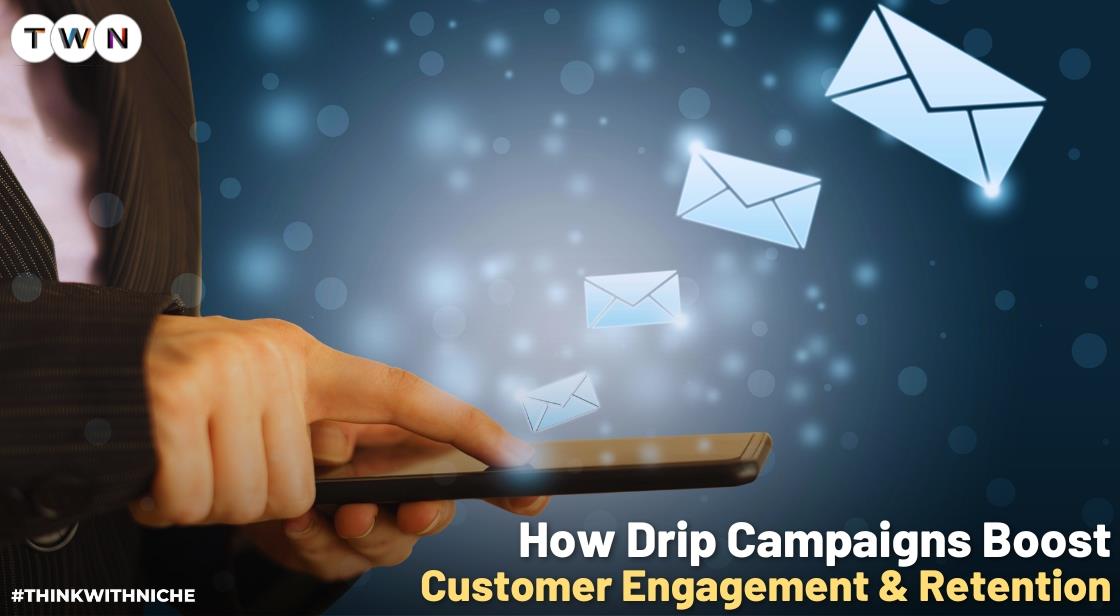How Drip Campaigns Boost Customer Engagement and Retention

Blog Post
In the fast-paced world of digital marketing, establishing meaningful connections with customers is more crucial than ever. One of the most effective strategies for achieving this is through drip campaigns—automated email sequences designed to nurture leads and engage existing customers over time. Whether you're welcoming new subscribers, re-engaging past customers, or providing valuable content, a well-crafted drip campaign can enhance your brand’s visibility and foster loyalty.
This guide delves into the essentials of drip campaigns, exploring what they are, why they matter, and how they work. From defining your goals to personalizing content and ensuring compliance with regulations, we’ll walk you through each critical step of creating a successful drip campaign. By the end of this article, you'll be equipped with the knowledge and strategies necessary to implement an impactful drip campaign that not only boosts sales but also strengthens relationships with your audience. Let’s embark on this journey to elevate your email marketing efforts and unlock the potential of drip campaigns!
The Essentials of Drip Campaigns in Marketing
What Is a Drip Campaign?
A drip campaign is a marketing strategy where a series of emails is sent to customers or interested users based on specific actions they take or according to a preset schedule. One common example is an email welcome series that gradually introduces new subscribers to a brand, helping them understand the offerings over several days. Another instance of a drip campaign is a birthday message, such as sending a personalized discount to celebrate a customer’s special day.
Drip campaigns can also include targeted emails recommending products related to a customer’s previous purchases. This approach helps brands maintain consistent communication, building familiarity and trust with customers over time.
Why Are Drip Campaigns Important?
Drip campaigns are a powerful tool for maintaining connections with both current and potential customers, fostering brand familiarity, and establishing lasting relationships. By delivering targeted content, these campaigns keep your brand at the forefront, even after visitors leave your website, encouraging continued engagement with what you offer.
One of the strengths of drip campaigns is their capacity for personalization; they can be precisely tailored to individuals based on location, shopping patterns, preferences, and other shared details. This segmentation capability is a key factor in their effectiveness as an email marketing strategy, as it enables businesses to nurture new leads with relevant content and drive additional sales from existing customers. Through this strategic approach, drip campaigns help ensure consistent brand visibility and support a more personalized, impactful customer journey.
How Does a Drip Campaign Work?
A drip campaign is a targeted marketing strategy designed to nurture leads and keep customers engaged through a series of automated emails. Here’s a simplified guide to setting up a drip campaign using email marketing software:
1. Select a Trigger:
Begin by choosing a trigger that activates the campaign. This is an action taken by the customer, such as signing up for a newsletter, abandoning a cart, or reaching a specific milestone (e.g., a year after their first purchase). Triggers are essential because they allow you to deliver timely, relevant messages that improve engagement.
2. Segment Your Audience:
Once you’ve established the trigger, segment your audience based on factors like behavior, preferences, or demographics. Tailoring messages to different groups, like new subscribers, returning customers, or inactive users, enhances the campaign's effectiveness. Proper segmentation ensures that each audience segment receives content most relevant to them.
3. Design the Email Series:
Create a sequence of emails that will be sent automatically as soon as the trigger is activated. Each email should have a specific objective that guides the recipient through a journey. For instance, the first email might welcome new subscribers, the second could showcase popular products, and the third could provide a discount to encourage purchases. Mapping out a clear email journey keeps recipients interested and engaged.
4. Set Timing and Frequency:
Determine the timing and frequency of each email to maintain a balance between staying connected and avoiding oversaturation. Decide how much time should pass between each email, as well as the ideal time of day to send them. Proper timing helps sustain interest without overwhelming recipients.
5. Personalize Content:
Utilize data such as names, purchase history, and previous interactions to personalize each email. Personal touches—like addressing the recipient by name or recommending products based on past purchases—boost engagement and foster a closer connection with the audience.
6. Monitor and Optimize:
Once your drip campaign is live, continually track its performance. Key metrics like open rates, click-through rates, and conversion rates provide valuable insights into its effectiveness. Adjustments can be made as needed to improve results, and A/B testing can further help optimize subject lines, content, and timing. By analyzing these metrics, you can refine your campaign to make it more effective over time.
Drip campaigns are a powerful way to nurture leads and build stronger relationships with your customers, providing them with timely, relevant information and personalized experiences that encourage loyalty and engagement.
5 Use Cases for a Drip Campaign
Drip campaigns are a strategic way to keep customers and subscribers engaged with your brand, sharing helpful information and building familiarity over time. Because each business has unique audiences and goals, the most effective use cases for a drip campaign can vary.
When planning a drip campaign, it’s essential to think about what your customers might need or want to know. For example, a skincare brand could create a campaign to email customers a few months after a purchase, reminding them to restock their product, perhaps with a discount as an extra incentive. By focusing on the user’s experience and their needs, you’ll increase the chances of delivering a successful drip campaign.
Welcome Campaigns
Welcome campaigns are one of the most common types of drip campaigns, ideal for introducing your brand to new subscribers. When someone signs up for your newsletter, it’s a great opportunity to engage while your brand is still top-of-mind. You can send a series of emails over several days or weeks, helping new subscribers get to know your brand and offerings.
A welcome series can include a variety of content, such as an exclusive discount for first-time buyers, educational information about your products, or insights into your brand’s story. Since welcome emails are typically part of a series, you have the flexibility to blend several themes, tailored to what you think will resonate most with your new audience.
Dana Carr, Director of Email Marketing at Optimove, suggests that segmenting your welcome series can make the content more personalized and effective. Here are some ideas on how to segment:
-
By User Type: Target your welcome emails based on whether the subscriber is a new customer, a new subscriber, or a returning customer.
-
For Non-Customers: Consider creating a nurturing campaign designed to encourage first-time purchases from new subscribers.
-
For Existing Customers: Design a re-engagement series to rekindle interest among previous purchasers, encouraging them to interact with your brand again.
Using segmentation allows you to deliver more relevant content, ensuring that each type of subscriber receives messages tailored to their specific needs and familiarity with your brand. By creating such targeted drip campaigns, you’re more likely to build meaningful connections with your audience, improving engagement and fostering customer loyalty over time.
After a Customer Makes a Purchase
Engaging customers after a purchase is an excellent opportunity, as they’ve just shown commitment to your brand. Use this moment to share information on related products, details about their recent purchase, or relevant educational content. Spacing these topics across several emails keeps the engagement ongoing. Providing valuable, interesting content beyond pure promotion makes it more likely that customers will interact with and appreciate your emails, strengthening their connection with your brand.
Abandoned Shopping Carts
You can set up campaigns for cart or browse abandonment to reach users promptly, capturing their interest while it's still fresh. Abandoned cart emails are effective because they target customers who were recently browsing your site and showed interest in a product. By following up quickly, these emails increase the chances of re-engaging potential buyers and reminding them of their intent to purchase. This timely approach helps nudge users back to complete their transaction, maximizing conversions by addressing their interest at just the right moment.
Requesting Feedback on Returns or Cancellations
Reaching out for feedback when a customer returns a product or cancels a subscription can provide valuable insights into their reasons for these actions. Many companies incentivize customers who unsubscribe by offering promotions or extending their subscription periods.
This strategy can be effective in retaining customers who may be hesitant about their decision or find the subscription cost too high. By understanding their concerns, businesses can make informed adjustments to improve customer satisfaction and potentially win back those who might reconsider their choice.
Sharing Educational Content Through Drip Campaigns
Another effective use of drip campaigns is to share educational content or courses over a designated period. This tactic is particularly beneficial for service-based businesses. For instance, a personal fitness trainer promoting their services online might consider providing a week-long email course. Each day, subscribers could receive an email featuring an exercise to try or a fitness tip to implement.
Offering a free email course not only engages potential customers but also helps them become familiar with your brand and approach. As they receive valuable content over the course of a week, they can better assess whether your paid services align with their fitness goals and needs. This method serves to educate your audience while simultaneously building a relationship that may lead to future business opportunities.
How to create a successful drip campaign
Define Your Goals
The first step in creating a successful drip campaign is to clearly define your goals. What do you hope to achieve? Whether it’s increasing sales, nurturing leads, boosting customer engagement, or enhancing brand awareness, having specific objectives will guide your entire campaign. Establish measurable outcomes, such as a percentage increase in sales or a specific number of leads generated, to help assess the effectiveness of your efforts.
Identify Your Target Audience
Next, it’s essential to identify your target audience. Understanding who your ideal customers are will enable you to tailor your messaging effectively. Segment your audience based on demographics, behaviors, and preferences to create targeted campaigns. This will allow you to craft messages that resonate with different groups, improving the likelihood of engagement and conversions.
Create Valuable Content
Once you know your goals and audience, focus on creating valuable content. Your emails should provide useful information that addresses your audience’s needs and interests. This could include educational materials, special offers, product updates, or insightful tips related to your industry. High-quality content not only fosters engagement but also builds trust with your audience, encouraging them to take the desired actions.
Design the Drip Campaign
With your content ready, it’s time to design the drip campaign. Map out the sequence of emails you plan to send, determining the timing and frequency for each message. Consider using a combination of different types of content and varying email formats to keep the campaign fresh and engaging. A well-structured campaign will guide recipients through a logical journey toward your desired outcome.
Automate Your Drip Sequences
Automation is key to a successful drip campaign. Use email marketing software to set up your drip sequences, ensuring that emails are sent at the right times without manual intervention. Automation allows you to maintain consistency in communication, sending messages based on user actions or predefined schedules. This not only saves time but also ensures that your audience receives timely and relevant information.
Personalize Your Emails
Personalization is crucial for enhancing engagement in your drip campaigns. Use the recipient's name, tailor content based on their previous interactions, and recommend products or services that align with their preferences. Personalizing emails can significantly increase open rates and conversions, as customers are more likely to engage with content that feels relevant to them.
Test and Optimize
After launching your campaign, it's essential to test and optimize your emails continually. Monitor the performance of different elements, such as subject lines, email layouts, and calls to action. A/B testing can help identify what resonates best with your audience, allowing you to make data-driven adjustments for better results.
Keep an Eye on Your KPIs
Tracking key performance indicators (KPIs) is vital for assessing the success of your drip campaign. Monitor metrics such as open rates, click-through rates, conversion rates, and unsubscribe rates to gauge engagement and effectiveness. Regularly reviewing these metrics will help you identify trends and areas for improvement.
Ensure Compliance
Finally, ensure compliance with email marketing regulations, such as the General Data Protection Regulation (GDPR) and the CAN-SPAM Act. Provide clear opt-in options for your subscribers and include an easy way for them to unsubscribe from your emails. Compliance not only protects your business but also fosters trust with your audience, ensuring a positive experience.
By following these steps, you can create a successful drip campaign that boosts engagement, drives sales, and builds lasting relationships with your customers.
You May Like
EDITOR’S CHOICE












